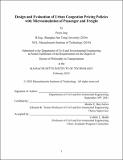| dc.description.abstract | With rapid urbanization and increasing mobility demand, urban traffic congestion has been growing. The contribution of urban freight to congestion has also been increasing due to surging e-commerce demand. Congestion pricing is effective for urban congestion mitigation, yet knowledge about its impacts on the freight sector is insufficient. We propose to design and evaluate congestion pricing policies using integrated microsimulation of urban passenger and freight.
First, we extend a state-of-the-art microsimulation system of urban passenger and freight for analyzing pricing strategy impacts. We integrate freight into the passenger components and incorporate cost sensitivity into the system. Specifically, we develop a freight vehicle operations planning model to capture the cost sensitivity of freight carriers in fleet tour planning.
Next, we develop methodologies for designing location-specific, vehicle-type-specific, and time-of-day-specific urban congestion pricing policies. We also develop an evaluation methodology to systematically assess three aspects of impacts: social welfare, network level of service (LOS), and behavioral patterns & logistics operations.
Finally, we design and evaluate distance-based, cordon-based, and area-based congestion pricing policies for an auto-innovative prototype city. All policies improve total social welfare. The improvement is the greatest under the distance-based policy and the area-based one follows it. We show profiles of passengers and shippers losing or gaining profits under congestion pricing. Passengers losing profits have lower value of time and household income whereas those benefiting are the reverse and have a higher proportion of work activities. Shippers losing profits have smaller business sizes, fewer shipments, lower shipment value whereas those benefiting are the reverse. All policies improve LOS in the toll area, especially the most congested subzones. The distance based and cordon-based policies are most effective during peak periods but the area-based one is less effective during peak periods. We also reveal heterogeneous impacts on behavioral patterns, including passenger’s and carrier’s mode choice, departure time choice, trip length, and logistics operations including shipper’s shipment size & frequency choice, carrier’s vehicle tour planning, etc. Logistics efficiency improves the most for e-commerce shipments and internal tours under the distance-based policy. The evaluation results contribute to the state of knowledge and provide insights for policy-making. | |
